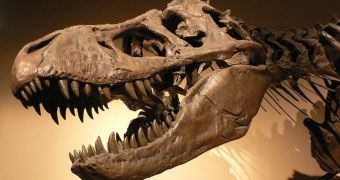More than two years ago, a team of researchers dropped a bomb-news on the international scientific community – they had found intact proteins from a Tyrannosaurus Rex, one of the largest carnivorous dinosaurs that ever lived. Critics naturally started jumping up and down, arguing that it was essentially impossible for a protein to survive for so long, and pointing at the fact that the signatures of the protein fragments, which were taken with mass spectrometry, were flawed. Now, an independent group of researchers have redone the calculations and measurements, and have learned that the original team did not make any mistakes in their analysis.
The amazing discovery was first announced in the journal Science in 2005, by a group of experts at the North Carolina State University in Raleigh, led by scientist Mary Schweitzer. The experts revealed at the time that they had found a peculiar T. Rex fossil that seemed to have had some of its blood vessels and other types of soft tissue preserved. Working together with Harvard Medical School mass-spectrometry expert John Asara, Schweitzer discovered seven peptide fragments in the samples, which the team inferred to have come from dinosaur collagen.
These fragments showed remarkable similarities to structures found in modern-day birds. This added further substance to the theory that birds were the direct descendants of dinosaurs. However, critics pointed out that the signal emitted by the peptides was too weak to be accurately determined from the background noise, and also that contaminants might have caused the “false readings.” After the ensuing debate, Asara decided to release the spectrometry data into the community, so that others could verify his work.
Experts at the Palo Alto Research Center, in California, and the University of California in Davis (UCD) took it upon themselves to check the readings for errors. According to ScienceNow, they used a different set of bioinformatics tools and statistical tests than in the original research, but found similar results to those of the Harvard expert. “In summary, we find nothing obviously wrong with the T. rex mass spectra: the identified peptides seem consistent with a sample containing old, quite possibly very ancient, bird-like bone, contaminated with only fairly explicable proteins,” the California team writes in an entry in this month's issue of the Journal of Proteome Research.
“That's pretty good news. I think it puts the mass-spectrometry interpretation to rest,” Asara says. He argues that another dinosaur fossil, this time 80 million years old, has since been discovered to sport similar protein markers, which were identified through mass spectrometry as well.

 14 DAY TRIAL //
14 DAY TRIAL //